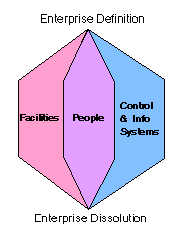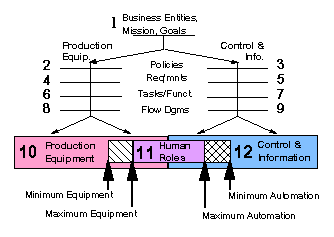PERA Human and Organization Architecture
 |
The Human and Organization
Architecture is one of three basic components of any enterprise (the
other 2 are the Production Facilites, and the Control and Information
Systems). In the PERA Model, it is usually depicted in the middle,
since even more that the other two, it has interfaces with both the
"Control and Information Systems" and the "Facilities".of the
enterprise.
|
The organizational structure of the enterprise may be represented by a
series of "Org Charts", beginning with very "high level" during the
conceptual Engineering Phase, and continuing to a complete definition
of all positions, responsibilites and work processes by facility
startup.
PERA does not define any additional diagrams or documents to
define the organizational and human aspects of the enterprise, since an
adequate set of these has already been evolved for each industry.
However, PERA does place these documents within an Architecture which
relates them to the appropriate enterprise development phase, and to
the other components of the enterprise.
The Organization is progressively developed during each phase
of the enterprise. Note that the development of the organization to
execute the project should not be confused with the development of the
organization for the actual enterprise. The organization chart for the
enterprise is progressively developed during each successive phase up
to operations. The organization for the engineering, construction,
etc., are complete and may be disbanded at the end of each phase.
There are modelling systems such as ARIS, which are designed
to simulate both the Human and Organizational and Control and
Information Systems components of the enterprise during a given
enterprise phase (typically operations).
These models can be valuable in that they model both the Human
actions and Informaton flows (at least for automated tasks). However,
they do not represent the production facility itself, nor any of its
control systems, so considerable manual interface work may still be
required if the model is to correctly predict industrial enterprise
behavior.
Also, they do not provide a mechanism for addressing maximum
and minimun "extent of automation", but rather just document the
selected degree of automation. Thus, when this level of automation is
modified, the impact on the human and facilities elements of the
enterprise are not immediately evident.

By contrast, the PERA Framework clearly demonstrates the
relationship between level of automation ( of both the control and
information systems and the faciltiy ), and its effect on the human and
organizational element of the enterprise.
by Gary Rathwell
© reserved
Back
to PERA Home Page

